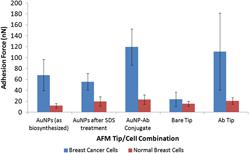Crossref Citations
This article has been cited by the following publications. This list is generated based on data provided by
Crossref.
Yang, Mei
Yao, Jun
Liu, Yu
and
Duan, Yixiang
2014.
Sensitive detection of mercury (II) ion using wave length-tunable visible-emitting gold nanoclusters based on protein-templated synthesis.
Journal of Materials Research,
Vol. 29,
Issue. 20,
p.
2416.
Obayemi, J.D.
Dozie-Nwachukwu, S.
Danyuo, Y.
Odusanya, O.S.
Anuku, N.
Malatesta, K.
and
Soboyejo, W.O.
2015.
Biosynthesis and the conjugation of magnetite nanoparticles with luteinizing hormone releasing hormone (LHRH).
Materials Science and Engineering: C,
Vol. 46,
Issue. ,
p.
482.
Dozie-Nwachukwu, S.O.
Obayemi, J.D.
Danyo, Y.
Etuk-Udo, G.
Anuku, N.
Odusanya, O.S.
Malatesta, Karen
Chi, C.
and
Soboyejo, W.O.
2015.
Biosynthesis of Gold Nanoparticles with <i>Serratia marcescens </i>Bacteria.
Advanced Materials Research,
Vol. 1132,
Issue. ,
p.
19.
Dozie-Nwachukwu, S. O.
Obayemi, J. D.
Danyuo, Y. T.
Etuk-Udo, G.
Chi, Y.
Hu, J.
Anuku, N.
Odusanya, O. S.
Malatesta, K.
and
Soboyejo, W. O.
2017.
Biosynthesis of Gold Nanoparticles and Gold/Prodigiosin Nanoparticles with Serratia marcescens Bacteria.
Waste and Biomass Valorization,
Vol. 8,
Issue. 6,
p.
2045.
Dozie-Nwachukwu, S. O.
Obayemi, J. D.
Danyuo, Y.
Anuku, N.
Odusanya, O. S.
Malatesta, K.
and
Soboyejo, W. O.
2017.
A comparative study of the adhesion of biosynthesized gold and conjugated gold/prodigiosin nanoparticles to triple negative breast cancer cells.
Journal of Materials Science: Materials in Medicine,
Vol. 28,
Issue. 9,
Obayemi, John D.
Hu, Jingjie
Uzonwanne, Vanessa O.
Odusanya, Olushola S.
Malatesta, Karen
Anuku, Nicolas
and
Soboyejo, Winston O.
2017.
Adhesion of ligand-conjugated biosynthesized magnetite nanoparticles to triple negative breast cancer cells.
Journal of the Mechanical Behavior of Biomedical Materials,
Vol. 68,
Issue. ,
p.
276.
Ani, C.J.
Obayemi, J.D.
Uzonwanne, V.O.
Danyuo, Y.
Odusanya, O.S.
Hu, J.
Malatesta, K.
and
Soboyejo, W.O.
2019.
A shear assay study of single normal/breast cancer cell deformation and detachment from poly-di-methyl-siloxane (PDMS) surfaces.
Journal of the Mechanical Behavior of Biomedical Materials,
Vol. 91,
Issue. ,
p.
76.
Elegbede, Joseph Adetunji
and
Lateef, Agbaje
2019.
Green Nanotechnology in Nigeria: The Research Landscape, Challenges and Prospects.
Annals of Science and Technology,
Vol. 4,
Issue. 2,
p.
6.
Tripathi, R.M.
and
Chung, Sang J.
2019.
Biogenic nanomaterials: Synthesis, characterization, growth mechanism, and biomedical applications.
Journal of Microbiological Methods,
Vol. 157,
Issue. ,
p.
65.
Anuku, Nicolas
Obayemi, John David
Odusanya, Olushola S.
Malatesta, Karen A.
and
Soboyejo, Wole
2020.
Bioinspired Structures and Design.
p.
212.
Obayemi, J. D.
Salifu, A. A.
Eluu, S. C.
Uzonwanne, V. O.
Jusu, S. M.
Nwazojie, C. C.
Onyekanne, C. E.
Ojelabi, O.
Payne, L.
Moore, C. M.
King, J. A.
and
Soboyejo, W. O.
2020.
LHRH-Conjugated Drugs as Targeted Therapeutic Agents for the Specific Targeting and Localized Treatment of Triple Negative Breast Cancer.
Scientific Reports,
Vol. 10,
Issue. 1,
Soboyejo, Wole
and
Daniel, Leo
2020.
Bioinspired Structures and Design.
Uzonwanne, Vanessa O.
Navabi, Arvand
Obayemi, John D.
Hu, Jingjie
Salifu, Ali A.
Ghahremani, Shahnaz
Ndahiro, Nelson
Rahbar, Nima
and
Soboyejo, Winston
2022.
Triptorelin-functionalized PEG-coated biosynthesized gold nanoparticles: Effects of receptor-ligand interactions on adhesion to triple negative breast cancer cells.
Biomaterials Advances,
Vol. 136,
Issue. ,
p.
212801.
Onwudiwe, Killian
Burchett, Alice A.
and
Datta, Meenal
2022.
Mechanical and metabolic interplay in the brain metastatic microenvironment.
Frontiers in Oncology,
Vol. 12,
Issue. ,





